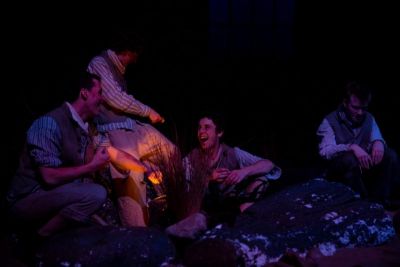Point of No Return
Alaine Beek creates a ‘pressure cooker’ environment in which isolation, hunger, filth and cruel punishments aggravate conflicts between four boys transported to a remote prison in 19th century Tasmania. Worse, their guards are former inmates of the notorious Port Arthur prison, just across a narrow stretch of sea.
A trio of ‘old hands’, led by ‘Red’ (Will McDonald) are sequestered in a separate workshop for their ‘rehabilitation’. Bones (Alex Roe) is the tough guy. Ardy (Jeremy Withers) is the sickly former chimney sweep with a dreadful secret. They have some measure of protection because their particular guard, Hawkins (Phil Cameron-Smith), a former convicted criminal himself, is an old mate of Red’s father, incarcerated in Port Arthur. The new arrival is Jeremiah (William Farnsworth); he’s smaller, naïve but buoyed up by his faith in Jesus and the only one of them who can read.
Ms Beek, who also directs, has cast well. We have a fair idea of character before her actors say a word. Red’s authority over the others comes from his intelligence and Mr McDonald looks smart. Mr Roe quite likely has a future playing mean heavies, but meanwhile he has confidence and presence. Mr Withers’ scrawny stoop and mop of curls identifies him as the perpetual scapegoat and victim while Mr Cameron-Smith looks like the kind of guy you’d want on your side in a pub brawl. Mr Farnsworth as the new boy has a less promising role. We expect his character to be more of a catalyst than he is in the story as it unfolds.
 It’s also unfortunate that all of them resort to shouting to convey strong emotion. It’s a common failing and it’s tiring, unconvincing and gets in the way of clarity. Mr Cameron-Smith, for instance, could be far menacing if he were to speak – at least sometimes - in a seemingly calm and even way. Mr McDonald, as the boys’ leader, needs less volume and more reasonable persuasion. As it stands, the actors leave themselves nowhere to go.
It’s also unfortunate that all of them resort to shouting to convey strong emotion. It’s a common failing and it’s tiring, unconvincing and gets in the way of clarity. Mr Cameron-Smith, for instance, could be far menacing if he were to speak – at least sometimes - in a seemingly calm and even way. Mr McDonald, as the boys’ leader, needs less volume and more reasonable persuasion. As it stands, the actors leave themselves nowhere to go.
It’s unusual to see a straight play – especially a naturalistic one – in the Melba Spiegeltent, more commonly a venue for circus or cabaret. Ms Beek, working with Alan Thompson, adapts the space, leaving a platform that stands in for workroom and dormitory, and a lower playing area – surrounded by audience – is ‘outside’, that is, anywhere else, including a campfire and a solitary confinement cell. Lighting designer Ness Harwood provides a glittering starry sky as a backdrop which is most effective in suggesting the isolation of the setting, but I wondered if the stars should glitter between every scene? Design and direction decisions do rather constrain transitions: there’s a hiatus as the cast get onto and off the playing areas.
 In a program note, Ms Beek says that she has tried to capture teenagers’ ‘energy, their sudden emotional changes, their need [for] a sense of belonging, even their recklessness’. But the text seems more devoted to this and the inclusion of her detailed research than in character development or story. The real antagonist, crucial to the plot, is a sadistic guard called ‘Twister’. – but he never appears on stage. Likewise, another boy, Tom, whom we learn is in the sick bay as the play begins. Because they’re important, we keep expecting both to appear on stage, but they don’t. The characters on stage do change, but not in a cause-and-effect manner. It’s more a matter of revelations of their backstories that cause us to re-evaluate their characters. The really big changes the characters undergo – after the play’s dramatized story - are given us in an epilogue in which the characters – for the first time – address the audience directly.
In a program note, Ms Beek says that she has tried to capture teenagers’ ‘energy, their sudden emotional changes, their need [for] a sense of belonging, even their recklessness’. But the text seems more devoted to this and the inclusion of her detailed research than in character development or story. The real antagonist, crucial to the plot, is a sadistic guard called ‘Twister’. – but he never appears on stage. Likewise, another boy, Tom, whom we learn is in the sick bay as the play begins. Because they’re important, we keep expecting both to appear on stage, but they don’t. The characters on stage do change, but not in a cause-and-effect manner. It’s more a matter of revelations of their backstories that cause us to re-evaluate their characters. The really big changes the characters undergo – after the play’s dramatized story - are given us in an epilogue in which the characters – for the first time – address the audience directly.
Point of No Return, in different iterations,has been well and warmly received elsewhere, but it passes up the opportunity to connect with a present in which children are still being heartlessly locked up and mistreated – and why this happens. The play depicts, yes, a little-known part of our history, so it’s ‘true’, but its sincerity and the good intentions of all concerned don’t quite dispel its somewhat clumsy feel of this particular production.
Michael Brindley
Photographer: Imran Abul Kashem (Westend Photography)
Subscribe to our E-Newsletter, buy our latest print edition or find a Performing Arts book at Book Nook.
